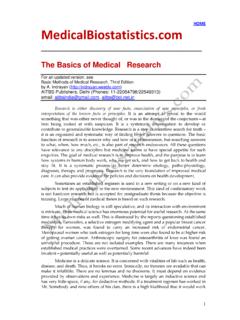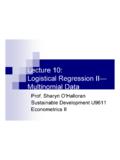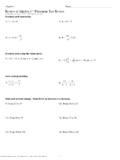Transcription of RELATIVE RISK, ODDS RATIO, ATTRIBUTABLE RISK AND …
1 1 HOME RELATIVE RISK, odds RATIO, ATTRIBUTABLE RISK AND NUMBER NEEDED TO TREAT An improved version of this article is now available in Third Edition (2012) of the book Medical Biostatistics (CRC Press, New York) by Abhaya Indrayan Adapted from Basic Methods of Medical Research, Third Edition by A. Indrayan ( ) Full details in Medical Biostatistics, Second Edition, 2008 by A. Indrayan Book details at 1 EPIDEMIOLOGICAL INDICES The research may or may not be epidemiological but there is a high likelihood that it would use the epidemiological indices discussed in this note.
2 Rate, risk, hazard, incidence, and prevalence are everyday indices of disease occurrence that are used in a large number of research endeavours. Although these indices apparently look simple but many researchers are not fully comfortable in their usage. The following description should be helpful in that case. RATE, RISK, HAZARD, AND odds Depending upon the focus, different indices are used to assess disease occurrence in a group of subjects. These can be explained as follows. RATE AND RATIO Akin to speed, rate is a measure of rapidity of occurrence of an event in a population.
3 Thus time is an essential element of this concept. It has to be per unit of time per day, per months, per year, etc. Rate is the frequency or the number of events that occur in a defined period of time divided by the population at risk for that event during that period. If the population varies from time to time within that period, such as at the beginning of the year and at the end of the year, it is conventional to use the average population, say at the middle of the year as an approximation.
4 Here in lies the catch. If a city has a population of 10,000 at the beginning of the year and 6,000 perish due to a severe earthquake in the month of February, the mid-year population would be nearly 4,000 (some would die due to routine causes and some births may take place). In that case the death rate, since based on mid-year population, for that year would be 6,0001,000/4,000 or 1,500 per 1,000 population, or per person! This rate would be entirely different if earthquake deaths occur in the latter half of the year.
5 This dramatic example illustrates that the mid-year or average population can be fallacious if deaths, for that matter any event for which rate is required, do not occur 2 regularly throughout the period at nearly a uniform rate. In fact the concept of rate is not applicable when such unusual spikes or dips occur. Ratio is the frequency of one item compared to another. Albumin-globulin ratio as a biochemical parameter and embolus-to-blood ratio for Doppler are examples.
6 Epidemiologists use sex ratio and dependency ratio. In all ratios , the two items under comparison are different entities, and none is part of the other. RISK AND HAZARD In general conversation, risk and odds are used interchangeably. Actually they do not have same meaning. We shortly explain odds but risk is the chance that a person without the disease will develop the disease in a defined period. It can be any other event or outcome such as accidental injury and vision becoming <6/60.
7 The term is generic and not restricted to adverse outcomes. It could be risk of survival or risk of reduction in side-effects, or risk of conception. Risk could be 1 in 1000 or or but can not exceed one. It is a decimal number although often expressed as percentage. Although the implication is for future events but the calculation is based on previous experience. The denominator is the number of persons exposed to the risk and numerator is that part of the denominator that develops the outcome. For example, ten-year risk of coronary heart disease (CHD) may be 9% in a population of age 40 79 years.
8 Such an estimate can be obtained only after follow-up of subjects for a 10-year period. This is based on past experience but would be used on future subjects. The population at risk for this calculation is not what was in the middle of the period but what was in the beginning of the period because all those are exposed to that risk. A measure of risk is the incidence rate, where also the denominator is the population at risk. This is discussed slightly later in this section. Risk can not exceed one but hazard has no such restriction.
9 If hundreds die within a few hours after plane crash, obviously the hazard of death is exceedingly high at that time than at a normal time. Hazard can be understood as the instantaneous rate of death for that matter, of any event of interest. It is sometimes called the force of mortality for deaths, force of morbidity for ill-health, and force of event-occurrence in general. It can also be understood as the intensity with which events occur at a point of time. Hazard can increase steeply in situations such as calamity and epidemic.
10 If constant over a period of time, hazard can be obtained by dividing the number of events in the target population by the exposure period. In many research setups, hazard in the exposed group is compared with the hazard in the unexposed group, such as comparing the rate of adverse reactions in the test and the control group. In such setups, the interest generally is in the hazard ratio instead of hazard itself. Hazard of death due to local anaesthesia may be one in a 100,000 but it could be one in a thousand for general anaesthesia.









